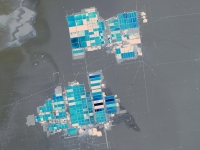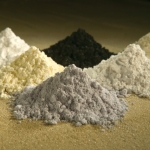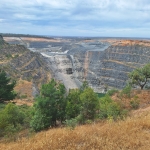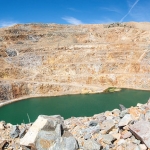Atacameño Take on Sociedad Química y Minera de Chile’s Lithium Mines

Lithium mining in the Atacama salt flats. Photo: NASA. Used under Creative Commons license.
Indigenous communities in Chile are trying to strike a deal with Sociedad Química y Minera de Chile (SQM), based in Santiago, Chile, and Albemarle, which is based in Charlotte, North Carolina, to reduce the environmental impact of the world’s largest lithium mines.
Lithium, the lightest metal, is used to make rechargeable batteries that are used in many modern electronic products like computers and smartphones. Mining for lithium is projected to increase some 500 percent in the next few decades.
The Lithium Triangle Approximately half of global lithium extraction takes place in Western Australia but this may change soon because about three-quarters of the world’s known reserves of lithium lie under the salt flats of Argentina, Bolivia and Chile in a region known as the “Lithium Triangle.” In Argentina, Rio Tinto is planning to spend $2.5 billion on the Rincon lithium mine. Another major mine under development is the Cauchari-Olaroz project which is operated by a joint venture between American Lithium (based in Vancouver, Canada, and Ganfeng Lithium, based in Xinyu, Jiangxi province, China. This mining is bitterly opposed by some 400 Indigenous groups in Jujuy, a province in northern Argentina, such as the Oclaya peoples. They have staged marches in the capital city of Buenos Aires, and roadblocks in towns like Purmamarca. Local police violently attacked Jujuy protestors in 2023 causing injuries to hundreds of local people. Meanwhile, in Bolivia, the Salar de Uyuni (Uyuni salt flats) have been targeted by the state-owned Yacimientos de Litio Bolivianos (YLB) which has cut two major deals. The first is with Uranium One Group, which is owned by the Russian government, to mine in Colcha K municipality, and the second is with Contemporary Amperex Technology Company Limited (CATL) the world’s biggest manufacturer of lithium-ion batteries, based in Ningde, China. These projects have also been angrily opposed by local Indigenous communities in Nor Lípez who expelled the minister of education from town when he arrived to consult with them in February 2025. |
Salar de Atacama (Atacama salt flats) - the world's highest desert which lies in coastal Chile - is at the center of this boom. It is one of the driest places in the world with an annual rainfall of just 10 centimeters a year which has been heavily impacted by the miners who use as much as a million tons of water to extract just one ton of lithium.
This is of great concern to the Atacameño peoples (also known as the Lickanantay) - the original Indigenous inhabitants of the region - who have made a living for centuries managing the limited water resources of their fragile environment for their alpaca and llama herds.
Albemarle and SQM use a technology called brine mining – which involves pumping salt water from underground caves into huge ponds the size of 200 Olympic-sized swimming pools and then evaporating the liquid in the sun. This can take as much as three years and it leaves behind vast quantities of toxic salts. Worse yet, this method only recovers between 20 and 40 percent of lithium from the brine.
Local leaders are very upset.
“Our habitat, our ecological niche is the desert and the sky, the stars, the universe, which form a combination that we call our home," David Barrera, a Lickanantay leader, told the Esperanza Project, an environmental website. "For us the care of the water, the blood that flows in the veins that cross our desert, has been fundamental. If the water stops flowing, there is no life."
“We have specific knowledge of our territory, of our water. And we have the power to close the salt flat if needed,” Yermin Basques, leader of the Toconao community, told Reuters news agency. “The companies have realized that interrupting production obviously has a damaging effect.”
“We have a totally different way of seeing the land, which does not coincide with the extractivist view,” Oriana Mora, an Indigenous Atacameño academic, told Mongabay, an environmental website. “[We] know how to live with its scarcity, tame it and even sometimes fear it.”
The Chilean government estimates that the two companies extract 2,000 liters of brine per second ie 63 billion liters every year, from 308 wells. University of Chile researchers used satellite imagery to show that the land around the mines are sinking by almost 2 centimeters a year.
Back in 2018, the the Indigenous Advisory Council of Atacameño Peoples successfully brought a complaint against SQM in the First Environmental Court for over use of water. The company has also been accused of bribery and corruption and has paid out $62.5 million to convince investors to drop lawsuits over bribery and tax fraud.
In the last couple of years, the companies have started to reach out to the local communities . “We have invited them to work together on a governance model that effectively recognizes and considers the perspectives and visions of the Lickanantay communities,” Codelco and SQM said in a joint statement to Reuters.
How much will change remains to be seen but the companies say that they are committed to change. "There is a lot of work still to be done, but in collaboration with our stakeholders, we are committed to investing the requisite efforts to achieve our shared vision," Ricardo Ramos, SGM’s CEO, said in a press release. “We will continue to build on our work to become the world’s most sustainable source of lithium, to contribute to the communities surrounding the Salar de Atacama and to work on further reducing our environmental footprint.”



